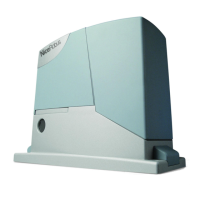GB
9
N°1 “Step-by-step” command
N°2 “Pedestrian gate” command
N°3 “Open” command
N°4 “Close” command
Table 5: commands available in Mode II
4.7) Memorization of Radio Transmitters
The “SM” radio receiver connector for SMXI or SMXIS type radio receivers has been provided in order to enable the user to control
ROBUS350 from a distance (see Figure 20). Each radio transmitter is recognised by the said receiver by means of a “code” which is differ-
ent from that of any other transmitter. It is thus necessary to carry out the “memorisation” procedure by means of which the user prepares
the receiver to recognise each single transmitter. Transmitters can be memorised in 2 modes:
Mode I: in this mode the function of the transmitter keys is fixed and
each key corresponds to the command in the control unit shown in
Table 4. A single stage is carried out for each transmitter, during
which all the transmitter keys are memorised. It does not matter
which key is pressed during this stage and only one place in the
memory is used. A transmitter can normally only control a single
automation in Mode I
Mode II: in this mode, each transmitter key can be associated with
one of the 4 possible control unit commands shown in Table 5. Only
one key is memorised for each stage, namely the one which was
pressed during memorisation. One place in the memory is occupied
for each key memorised.
In Mode II, different keys on the same transmitter can be used in
order to give the same automation more than one command or to
control more than one automation. For example, in Table 6, only
automation “A” is controlled, and the T3 and T4 keys are associated
with the same command. Alternatively, three automations are con-
trolled in the example shown in Table 7, namely “A” (keys T1 and T2),
“B” (key T3) and “C” (key T4).
Since the memorization procedures are timed (10s), you
must read the instructions in the following paragraphs before
you proceed with their execution
T1 key “Step-by-step” command
T2 key “Pedestrian gate” command
T3 key “Open” command
T4 key “Close” command
Table 4: Mode I memorisation
T1 key “Open” command Automation A
T2 key “Close” command Automation A
T3 key “Pedestrian Gate” command Automation A
T4 key “Pedestrian Gate” command Automation A
Table 6: 1st example of memorization in Mode II
T1 key “Open” command Automation A
T2 key “Close” command Automation A
T3 key “Step-by-step” command Automation B
T4 key “Step-by-step” command Automation C
Table 7: 2nd example of memorization in Mode II
Note: single-channel transmitters only have a T1 key, two channel transmit-
ters only have T1 and T2 keys.
1. Press the key on the receiver and hold it down (approx. 3 s)
3s
2. Release the key when the LED on the receiver lights up
3. Within 10s, press any key on the radio transmitter to be memorized and hold it down for at least 2s
2s
4. If the memorization procedure is successful, the LED on the receiver will flash 3 times.
x3
If there are other transmitters to be memorized, repeat step 3 within the next 10 s, otherwise the memorization stage will terminate
automatically.
Table 8: to memorize a transmitter in mode I Example
4.7.1) Memorization Mode I
1. Press the key on the receiver as many times as the number corresponding to the desired command,
according to table 5 1....4
2. Make sure that the LED on the receiver makes as many flashes as the number corresponding
to the selected command 1....4
3. Within 10 s, press any key on the radio transmitter to be memorized and hold it down for at least 2 s
2s
4. The LED on the receiver will flash 3 times if the memorization procedure has been successful
x3
If there are other transmitters to be memorized for the same type of command, repeat step 3 within the next 10 s, otherwise the
memorization stage will terminate automatically.
Table 9: to memorize the key of a transmitter in mode II Example
4.7.2) Memorization Mode II
20

